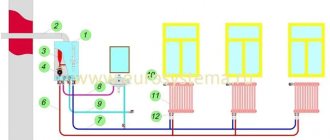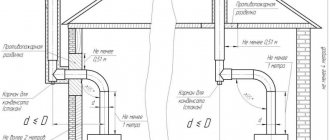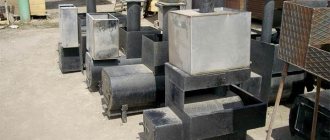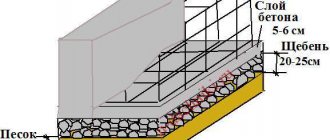Almost everywhere, natural gas is the cheapest energy source for heating a home. And if it is not possible to bring a pipe to the cottage, gas workers offer an option in the form of LPG. At first glance, gas heating with a gas holder looks like a good alternative, doesn’t it? Autonomous gasification guarantees independence and does not require approvals and lengthy obtaining specifications. However, everything has pitfalls.
We have studied all the pros and cons of liquefied petroleum fuel and will tell you how good it really is. The research we conducted will definitely help you decide exactly whether it is worth installing gas holder equipment on your site.
Storage container
A gas tank is a container for storing gas, and in a specific situation of heating a country house, it is a container into which LPG, liquefied hydrocarbon gases, a mixture of butane and propane are poured. LPG is not at all the same gas that is supplied to houses through main gas pipelines - it uses methane-based fuel.
A gas holder differs from a conventional gas cylinder in size and stationarity; it is installed on the site for several decades and is periodically refueled from a special refueling machine. An underground gas pipeline is laid to the house from the reservoir (it must be at a certain distance), through which the evaporated gas flows to the boiler.
Gas tanks are made of steel and treated with special anti-corrosion compounds. The device is equipped with sensors that help control gas flow and indicate the pressure in the tank.
The history of gas holders began in 1781 in the laboratory of the French chemist Lavoisier. To store gas in his laboratory, he made a rectangular container with a capacity of 100 liters, and after a few years he realized that the gas holder should be cylindrical. Further, gas holders were used mainly in science, industry and urban utilities (for gas lamps).
Over time and the development of science, gas tanks changed, modified, and finally a variety appeared that is used for heating private houses. These are cylindrical tanks of constant volume that can withstand high pressure: there are tanks in which gas is stored at a pressure of up to 18 atm.
Easy to connect
Natural gas connection
But here everything is very sad. Let's start from the beginning - if there is no gas pipe near your house. Check out Mosoblgaz's gasification plans for 2022. Perhaps soon an optimistic sign “Construction and installation work is underway” will appear in your village.
What if you don’t want to wait? You need to go straight to the gas company (it’s the only one in the region, you can’t go wrong) and prepare a budget. The budget depends on the proximity of the pipe to you, the appetites of the gas company and the requests of the contractors associated with it.
It's also worth being patient. Because gas workers are monopolists. And they have nowhere to rush. And if you are in a hurry, get ready to write to all authorities or “buy” a place in the queue.
There are reports that people with all the documents ready in hand wait a year or two for their turn, while less scrupulous neighbors get gasification out of turn.
By the way
If you want to gasify your house in 4 days, discuss the installation of liquefied gas with an engineer.
Conduct gas in 4 days
Sample list of documents for main gas installations
- Permission to connect.
- A copy of the registration certificate of the house.
- Topography of the land plot with gas pipeline and communications.
- A package of documents for the installed gas equipment (certificate of conformity, permission to use, contract for future maintenance).
- Chimney inspection report.
- Technical conditions for gas supply to a residential building.
- Design and approval of the location of gas equipment.
- Work estimate, contract for technical supervision.
- Agreement with a licensed installation organization.
- Executive and technical documentation.
- The act of acceptance by the commission of the completed scope of work.
- The act of sealing the gas meter. Agreement for periodic inspection of the gas pipeline route and maintenance of the shut-off device, gas supply.
Paperwork takes a long time to complete. If you do not turn to intermediaries and collect the documents yourself, you will have to take time off from work or even a full vacation. Just to travel to regional authorities and host numerous inspectors.
You will need to pay for each paper. If everything in your documentation is perfect, the pipe itself will be laid quickly.
It is the complexity of the connection and bureaucracy that forces people to remain on electric heating. The unaffordable procedure will not only not pay for the transition to main gas, but will also deprive you of your last nerves and philanthropy.
Gas tank connection
In the case of installing an underground tank, there is no paperwork from the word “absolutely”. You will only need real estate documents. You don’t even need a permit for excavation work - you are digging a pit on your own land.
The installation procedure with all the registration takes 3 days. Work on the site will take 8-9 hours: dig a pit, install a gas tank, run a gas pipeline to the boiler room, and bury the gas tank. Then the liquefied gas, like its “colleague” from the main line, constantly enters the heating boiler without your help.
4
Site installation requirements
A gas holder is a dangerous object. But it is no more dangerous than many other heating systems. The design has a safety valve that will not allow the container to be filled above the safe limit and will prevent the risk of rupture; There are fuses - if something happens they will release the pressure. You can install a sensor that will shut off the gas if a leak occurs.
The installation of equipment is controlled by a number of regulatory documents, including SP 42-103-2003 (it regulates the installation of gas pipelines made of polyethylene pipes). According to all the rules, the tank must defend:
- 10 meters from a residential building;
- 2 meters to the foundations of other buildings;
- one and a half heights of the support to local power lines.
The place where the gas tank is buried cannot be concreted, planted with plants or paved with tiles. The walls of the pit should be flat, 2 meters wide and at least 1.9 meters deep. The length of the pit depends on the volume of the container:
- 5 meters for a gas holder with a volume of 4850 liters;
- 7 meters for a gas holder with a volume of 6400 liters;
- 10 meters for a gas tank with a volume of 9200 liters.
The tank fittings must always be above ground level, and there must be free access to the neck for refueling.
It is important that the nameplate, plate on which the serial number and basic information about the gas tank are indicated can be freely read at any time of the year throughout the entire service life of the equipment.
Rating of the 5 best gas tanks for installation in the Moscow region
We analyzed in detail information about manufacturing plants and studied reviews of their products on the Internet. As a result, we were able to create an up-to-date rating of gas tanks for 2022.
| Place | Gas holder | Year of start of production of gas tanks | Country of Origin | Certificates | Guarantee | Price per tank 4850 liters |
| 1 | SPECGAZ | 2014 | Russia, Saint-Petersburg) | Russia, EU | 25 years | from 219,000 rub. |
| 2 | VPS | 1953 | Russia (under Czech control) | EU, Russia | 30 years | from 240,000 rub. |
| 3 | BEAR | 2014 | Russia (Moscow region) | Russia | 35 years | from 250,000 rub. |
| 4 | Chemet | 1990 | Poland | EU, Russia | Lifetime | from 385,000 rub. |
| 5 | CITY-GAS | no data | Bulgaria | EU, Russia | 20 years | from 210,000 rub. |
Profit or ruin
How profitable is a gas tank, does it pay for itself, and when does it make sense to install it in a country house or country house, and when not? This issue has been discussed on FORUMHOUSE for many years. There is no universal answer here, each case is individual, it all depends on the size and quality of insulation of the house, the climate of the region, and the prices of other types of fuel.
But here are the things we managed to agree on:
- Gas tank heating will be more profitable if you fill the tank once a year, in May. The cost of fuel in May is 20% lower than in October. But for this, the tank must have a sufficiently large volume.
- Gas holder heating is definitely cheaper than diesel heating, and in a number of regions of our country in terms of return on investment it ranks second after natural gas;
Westpoint FORUMHOUSE Member
Barrels with a volume of 4850 for a house of 130 sq.m. Should be enough for a year with a one-time refill. This is half of what I spend on pellets now.
- If the area of the house is more than 100 square meters, an autonomous gas heating system based on a gas holder may already be appropriate. If you just need to heat a small dacha, it would be better to go with electricity.
spbplumbing FORUMHOUSE Member
It all depends on capital investments, but a gas holder will be cheaper than a diesel boiler with piping, a chimney, a container, and installation.
KhrunchaModerator FORUMHOUSE
Personally, I don’t regret at all [that I buried the gas holder]. Ownership experience 8 years.
Even those people who loudly regret having installed gas tanks do not want to sell them.
Here are some reviews of how much it cost to heat a home with LPG for users of our portal last year, 2022.
MblParticipant FORUMHOUSE, Moscow.
The total area is 150 square meters + sauna 70. Of these, I constantly heat 60-70 m to + 21 degrees, in the sauna I maintain +5 all week, and +21 on weekends. Consumption per year under this regime is 40,000-45,000 rubles. There are about 2500 liters. I have a barrel with a volume of 4850 liters.
A member of our portal with the nickname IlyaKu has been operating a 6400 liter gas tank for four years. The area of his house is 10 square meters, and he chose such a large tank, planning to subsequently connect his relatives’ house to it. Both houses are permanent residences, without heated floors, with radiators.
IlyaKuForumHouse Member
While there was one house of 160 m2, there was enough fuel for the whole year and with a huge supply, the supply allowed you to choose when it was more profitable to refuel (minimum price May-June, maximum October-December).
After connecting the second house, a house with an area of 140 m2 has to be refueled twice a year, in total for two houses in 2022 it came out to 119,000 rubles, in the past 129,000.
FORUMHOUSE members who live close to each other find partners on the forum to refuel together. Judging by the reviews, this allows you to save from 50 kopecks to a ruble for each liter - it is much more profitable for gas stations to carry full tanks.
But this is about fuel consumption; Many people are more afraid of the cost of installing equipment. They are indeed considerable, but – and this can be looked at from different angles.
ChaleFORUMHOUSE Member
Believe me, compared to the cost of a house with some furniture and appliances, 350 thousand for everything including the first gas station will seem like a small amount.
Conclusions on the topic
| Fuel type | Efficiency | Connection cost | Fuel cost | Connection speed | Safety |
| Natural gas (mainline) | 97% | 350-500 thousand rubles | 2000 rubles per month | From a month to six months | High, with proper operation and timely maintenance |
| LPG (gas holder) | 97% | from 350 thousand to several million rubles | 5000 rubles per month | 1-3 days | High, with proper operation and timely maintenance |
So, if there is a gas pipe near your house and you are ready to wait, connect to it.
Connection prices will be comparable to a gas tank, but you will be able to save on fuel costs in the long run. If the highway is located far away and your site meets the basic requirements, then we advise you to dig a pit for the tank. This way you can ensure autonomous gasification of the entire site in a short time.
Which option did you choose? How long did it take to coordinate the connection to the main gas pipeline? Which gas holder did you choose and how quickly was it installed? Remember, our experts will answer all your questions.
How to choose the volume of a gas tank
Modern industry produces different types of gas tanks. They differ in volume, design, type of location, material and wall thickness, price, and manufacturer. To choose the right one, you need to consider many different points.
The first criterion for choosing a gas tank is volume. Now gas tanks with a volume of 900 to 10,000 liters are offered, but it is better to buy one that is spacious enough so that you have to refuel no more than once a year - this is the most profitable tactic.
MblFORUMHOUSE Member
Typically, a 4850 capacity is enough for a house with an area of 190 square meters.
It is difficult to accurately calculate the volume; manufacturers recommend calculating fuel consumption using the formula 22–25 liters of gas volume per meter of house area. You can trust these companies, but it's better to be safe.
KhrunchaModerator FORUMHOUSE
Less than 4.8 cu. m. don't take it! The principle here is the same as in a car: you don’t have to wait until the bottom of the tank, it’s better to refuel in advance.
Most manufacturers strongly recommend adherence to the following filling parameters:
- not less than 5% (there should not be less fuel in the tank)
- no higher than 85% (do not fill the container more).
These indicators make it possible to maintain a working pressure in the gas tank at which its operation will be safe.
Summarize
- In terms of price-quality ratio, the undisputed leader was the St. Petersburg plant “SPETSGAZ”.
- In second place is the Czech brand VPS, which produces containers at the same plant.
- BEAR took third place, as it lost to the first two brands in terms of price and compliance with international quality standards.
- Polish Chemet took 4th position due to its high cost.
- On the last line of the top is the Bulgarian CITY-GAS due to the lack of an officially established manufacturer’s warranty period.
Vertical or horizontal
Gas tanks that are installed vertically are of more interest to owners of small plots: this way they can comply with all placement requirements and save precious space. This is the most important advantage of vertical gas holders, and for this reason they are so popular in European countries.
In our country of large territories and high groundwater levels, the horizontal option is more common.
Andrey2 Member of FORUMHOUSE
It is cheaper to bury a horizontal one, but if the groundwater level is high, then the vertical one is more difficult to install.
About the fact that “vertical gas tanks have a small evaporation mirror, and with a large analysis there may be a lack of gas fraction” - on the portal there are quite a few owners of vertical tanks who did not feel any inconvenience at all from the small evaporation mirror.
Principle of operation
The principle of operation of a gas tank is quite simple: gas is pumped into a tank, and due to the fact that the tank is not completely filled, an air-gas mixture (propane-butane) is formed in the empty space of the storage. In order for the natural evaporation process to take place effectively, several rules should be followed:
- Do not fill the container with liquefied gas more than 85%.
- When installing a tank, it is necessary to strictly take into account that it should not be cooled below 0°, therefore, if a ground-based gas tank is installed, it will need to be insulated.
- If it is assumed that the evaporation area will be small (for example, in vertical containers), then it is necessary to consider an additional system of evaporators.
The gas mixture enters the house through a pipeline, just like through a regular pipeline. The gas tank is filled by specialists working on a machine with a filling tank. The procedure itself is reminiscent of refueling a car at a gas station.
Above ground or underground
Based on the type of occurrence, reservoirs are divided into above-ground and underground. In most cases, Russian homeowners choose underground ones. This is a dire necessity. How a gas tank works: at positive temperatures, the liquefied fuel in it evaporates and turns into gas, the valve opens, and the gas flows through the gas pipeline into the house, to the boiler. Under the ground around the walls of the container there are always positive temperatures - this is the main advantage of an underground gas tank. And the ground-based one may need to install special evaporators.
CrimsonFORUMHOUSE Member
That’s why large gas tanks are buried to prevent them from freezing. And preferably with a high neck, so that the gas itself is deeper - it’s warmer there.
But some owners of gas tanks believe that all tanks, regardless of the type of location, need additional heating of the gearbox.
StanspbFORUMHOUSE Member
In winter, it can freeze to very low temperatures, crack and stop regulating the gas supply. So I consider it necessary to heat the gearbox.
There is another type of gas holder - mobile or portable.
Usually this is a gas tank for the country - a cylinder with a capacity of about 700 liters on a car trailer that can be transported to a gas station. Mini gas holders cope with their tasks quite well.
MosKvachFORUMHOUSE Member
The mobile is placed on the base or works directly from the trailer. Moreover, there are also winter kits to prevent freezing in cold weather.
What you need to know before buying a gas tank: features and selection criteria
In order not to make a mistake in choosing and purchase a model that will suit all parameters, we will consider the main criteria by which you need to make a choice.
Strength. Due to the fact that the gas inside the gas tank forms evaporation, the pressure inside the container is always increased. In order for the walls of the tank to withstand such pressure, their thickness must be in the range of 6-12 mm. Durable structural steel is used as the manufacturing material. All welds must undergo additional processing to avoid divergence of the container along the joint line. And in the case of using tanks in conditions of very low temperatures (below -40°C), additional reinforcement is also done using internal partitions.
When purchasing a gas tank, you must take into account its technical characteristics
The second important aspect is the container’s resistance to corrosion . Considering the fact that the gas tank will be underground for many years and even decades, it must be as resistant as possible to any external factors. To prevent steel from corroding, it is coated with a special compound, for example, polyurethane, bitumen or epoxy.
Which option is best to choose? Bitumen coating is cheaper than others, however, it does not last long. Epoxy provides reliable long-term protection, but subject to maintaining its integrity. And given that it is quite fragile and breaks even from the slightest blow, this can be difficult. Polyurethane coating is considered the most reliable, as it is very resistant to mechanical stress.
Another important measure to prevent corrosion processes is electrochemical protection . Such devices can be “active” or “passive”. In the first case, cathodic protection stations are used, and in the second, anode-cathode systems are used. Both are designed to compensate for deficiencies and damage, as well as to increase the service life of the gas tank.
Gas supply diagram for a private house using a gas holder
It is worth paying attention to the quality of shut-off and safety valves , as well as the filling elements of the tank, since this factor largely determines the reliability of the gas tank. Your task is to make sure that all elements are durable, free of damage, resistant to corrosion and low temperatures. The importance of this parameter is difficult to underestimate, since it is the one that becomes decisive when it comes to the absence of gas leaks.
Material and wall thickness
Household gas tanks are made of steel, and its grade and thickness depend on the manufacturer. Domestic manufacturers usually use low-alloy steel 09G2S and 17G1S and apply a layer of bitumen to the containers. Experts always recommend checking the bitumen coating layer of the gas holder to ensure that there is no damage to them.
According to GOST 14249-89, for a design pressure of 1.8 MPa, the design wall thickness should be at least 6-6.13 mm (for vessels with bottoms of 1200-1250 mm.) And most domestic manufacturers adhere to this standard. The wall thickness of foreign-made gas tanks is 4.5 -5.7 mm.
SLEngineer, FORUMHOUSE user
You need to take domestically produced gas tanks with a wall thickness of 8mm.
But foreign gas tanks are made of steel, the quality of which is higher.
RavenFORUMHOUSE member, metallurgist
In Europe, there is a different approach - good steel, which does not make sense to make thick; professional coating is applied without air and solvents at high temperatures.
Users of our portal bought different gas tanks, there are those who are not happy with the domestic ones “made of thick steel”, there are those who are satisfied with the “bourgeois” ones. Here you need to make a choice, as with any other responsible purchase - and a gas tank is bought for 20-40 years - study the forum, read reviews, ask for advice.
KhrunchaModerator FORUMHOUSE
Personally, after 3 years of studying, I settled on an imported barrel, it is made of good steel, and even coated with epoxy.
Another point is the high neck of the gas tank, how much is it needed? This design feature makes the gas tank several tens of thousands of rubles more expensive.
BlehmanFORUMHOUSE Member
A high neck, in addition to protection from high groundwater level, allows you to maintain and, in the long term, examine the condition of the gas holder without digging it up, and to deepen the body of the gas holder to a depth more comfortable for LPG evaporation.
In practice, this difference of 30-50 cm does not give much, but you can examine the condition of the gas tank without it. Here people pay, rather, for their own peace of mind and confidence in the safety of gas equipment.
BaracudaMyNikFORUMHOUSE Member
The high neck is my peace of mind, plus, as they say, double welding. I will definitely take it from the high end.
Neck arrangement
Currently, three standards are offered. The choice depends on the characteristics of the soil in which the container will be installed.
- Eurostandard
. Low neck and multi-valve (all valves on one pipe). For sandy soils with low groundwater and shallow freezing depth. Advantages: inexpensive. Disadvantages: not intended for clayey and saturated soils. - Russian standard
. High neckline. For clayey and water-logged soils with large freezing depths. Advantages: no risk of flooding. Disadvantages: it is more expensive, plus high installation costs. - Eurostandard+
. Low neck and high pipes. Advantages: the same as those of the Russian GOST. Disadvantages: not suitable for moving and heaving soils, there is a risk of damage to the pipes
Gas tanks for a private home: prices, review of popular manufacturers
A large selection is often not to the benefit of buyers, since it is quite easy to get confused in the characteristics and offers, and the chances of buying something wrong increase significantly. Let's look at several manufacturers whose tanks are deservedly popular and are often purchased for use in private homes.
Turnkey gas tanks: prices and product features Deltagaz (Czech Republic)
The Czech company Deltagaz is quite well known in both the European and Russian markets. This is due to the fact that its products fully comply with the standards and are excellent for use in our country. The company offers several models designed for horizontal installation. They differ from each other only in volume - 2700, 4800, 6400 liters, etc. The same temperature limits are set for all options: from -20 to 40°C.
High neck gas tank
Among the arguments in favor of this choice are:
- durable 8 mm walls with epoxy anti-corrosion coating;
- the warranty period is 20 years, although, as practice shows, with proper handling the tank fully retains its characteristics for 50 years;
- The neck height is 75 cm, which allows you to dig the tank quite deeply. This is an undoubted advantage, given the depth of soil freezing in winter.
Since the tanks are produced in Europe, their cost in Russia is not too low. The price of a turnkey gas tank for a private house Deltagaz 2700 will be about 170 thousand rubles.
Gas tanks manufactured by VPS
The tanks of this company are somewhat different from the previous version and have a number of advantages. For example, the temperature limits within which containers can be used are noticeably wider: from -40 to 40°C. In addition, the manufacturer provides a 30-year warranty on its products.
Large gas tank for a large house
All models have a horizontal layout and are made of sheet steel, on which a layer of epoxy anti-corrosion protection is applied. On sale you can find models with a volume of 2700, 4850, 6400, 9150 and 9950 liters. However, despite these advantages, the price of installing a gas tank will be almost the same as for Deltagaz models.
Turnkey gas tanks Chemet
Polish Chemet tanks are widely known for the durable polymer coating used in their manufacturing process. There are also several additional technical characteristics that increase the price, but at the same time extend the service life of the tanks: only high-quality steel is used and there are reliable stiffeners inside the tanks.
For use in the Russian climate, three models of different volumes are available: Chemet 5, Chemet 6 and Chemet 9, with a capacity of 4850, 6400 and 9200 liters, respectively. Moreover, all three models are designed for horizontal installation. The cost of gas tanks from this company starts from 330 thousand rubles, excluding installation and connection of the system.
Tank for horizontal installation
Gas tanks for a private house on a turnkey basis from the manufacturer Fas
The Russian-German enterprise Faskhimmash also offers customers fairly high-quality products that are quite capable of competing with European tanks. Turnkey installation of a gas tank for a private home is possible thanks to the availability of five models: Fas 4.6, Fas 6.5, Fas 8.5, Fas 9.2 and Fas 20. These numbers are not only the name of the model, but also indicate the volume of the tank in thousands of liters.
To protect the housing, the manufacturer uses a two-component polymer material, which allows you to extend the trouble-free service life of the tank to 30 years. At the same time, for the Fas 4.6 model, the price of installing a gas tank in a private house with a full range of services will be about 200 thousand rubles.











